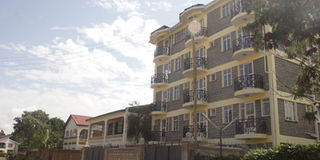Growing need for housing, rising cost of land see Kisumu’s Milimani Estate lose its serenity

The need for more housing, coupled with the rising cost of land, is slowly changing the face of the once serene Milimani Estate in Kisumu. Several high-rise buildings and apartments are now part of the landscape of an estate that was designated a low-density residential area and boasted bungalows and maisonettes with sizeable compounds. PHOTO | TOM OTIENO
What you need to know:
- The Estate was designated a low-density residential area and boasted bungalows and maisonettes with sizeable compounds. However, several high-rise buildings and apartments are now part of the landscape.
- He said the county government should redevelop the old estates that were built by the National Housing Corporation in the early 1990s, and which have not been maintained for decades.
- The acute housing shortage is expected to ease with the government’s 350 housing units in Mamboleo and Shauri Moyo nearing completion.
The need for more housing, coupled with the rising cost of land, is slowly changing the face of the once serene Milimani Estate in Kisumu.
The Estate was designated a low-density residential area and boasted bungalows and maisonettes with sizeable compounds. However, several high-rise buildings and apartments are now part of the landscape.
Kisumu County Director of Housing Mr Ben Osewe said investors were seeking to maximize use of the prime land as the demand for higher density settlements, office space and other infrastructure increases in the area due to its proximity to the central business district (CBD).
“Milimani is no longer a purely residential place. It is a mixed-use zone,” he said. “If a piece of land costs Sh50 million, there is no way an investor will put up a bungalow or two storeys only. It would not make business sense. That is why it is changing from a low- to a high-density area,” he said.
But the Kisumu County Executive for Land and Housing, Mr Derrick Obura, said those putting up high-rise buildings were breaking the law.
“Zoning has not been scrapped but some developers took advantage of the vacuum that existed when the defunct municipal council was winding up before the county government came in to put up those buildings,” he said.
He, however, said there are proposals to have some sections of Milimani incorporated in the CBD’s high-density area. The Kisumu Integrated strategic development (ISUD) Plan seeks to allow the construction of buildings of up to 12 storeys from the current three in the estate.
Roadmap for infrastructure
The plan, which is part of the Kisumu Urban Project, aims to provide a roadmap for the town’s infrastructural development in relation to the people’s growing needs, and especially open up more land in slums like Nyalenda, Obunga, Bandani and Kaloleni for investment.
HOUSING SHORTAGE
“The ISUD plan guides how a given area is used. We are in the process implementing the zoning and regulations,” said Mr Obura.
Named a Millennium City by UN-Habitat in 2006, Kisumu faces a serious housing challenge as it strives to accommodate its growing population, particularly the middle class.
Mr Osewe, said it was unfortunate that estates within a radius of five kilometres from the CBD had small, dilapidated houses occupying lots of space. Worse still, the residents had put up unsightly extensions.
“Getting land is a major challenge and we cannot continue wasting space with such single units,” Mr Osewe said.
He said the county government should redevelop the old estates that were built by the National Housing Corporation in the early 1990s, and which have not been maintained for decades.
“Let the county government seek public private partnership to build decent houses and develop public amenities around them,” he said.
Mr Osewe said that unless Kisumu begins preparing for the increased population envisaged by Vison 2030, it will face a serious housing shortage.
“Investors tend to be biased towards providing high-class housing so the shortage is felt more among the lower cadres,” he said.
However, Mr Obura said there are disputes preventing the county government from implementing the housing project immediately. For instance, he said, the NHC was not fully paid for the houses it built and was, therefore, threatening to take them back
“We stopped them, but that doesn’t mean we can begin making radical changes like demolishing and building new structures yet. There are a lot of negotiations to be done,” said Mr Obura.
The acute housing shortage is expected to ease with the government’s 350 housing units in Mamboleo and Shauri Moyo nearing completion.
Work on the Sh729 four-storey units in Shauri Moyo which are at roofing stage, began last year and are expected to be completed by mid-January next year. They comprise 60 one bed-room units, as well as 120 two-bedrom and 70 three bed-room houses.
“The two bedroom units cost Sh4.8million each while the three-bedroom ones are going for Sh6.6 milion each,” said Mr Osewe.
The government plans to sell some of the houses under a civil service mortgage scheme and rent out others to public servants.
There are also plans to carry out a second phase of the scheme on a 2.5 hectare piece of land once the ongoing project is completed.
Meanwhile, 100 of the proposed 1,000 units in Mamboleo are ready and up for sale.





